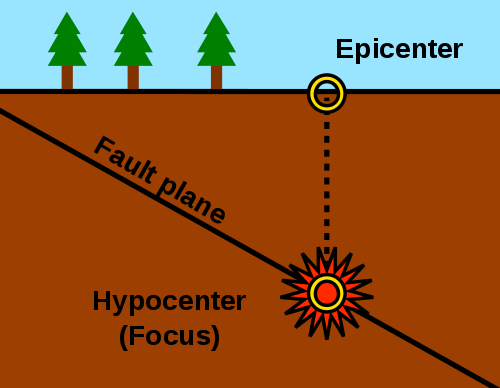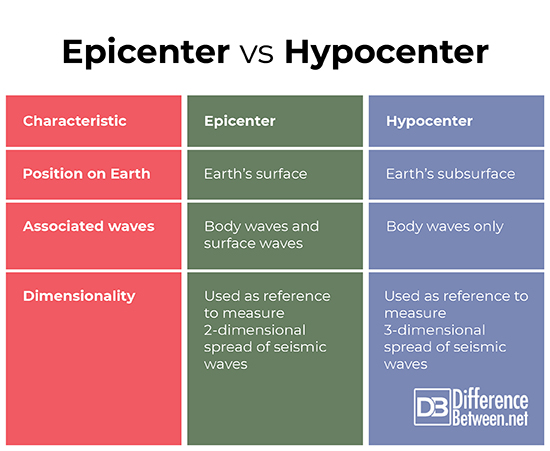Difference Between Epicenter and Hypocenter
What is an Epicenter?
The epicenter is the location on Earth’s surface directly above where an earthquake occurs and spreads. It is used as a reference point by seismologists to study the spread and effects of earthquakes.
Nature of Earthquakes
Earthquakes are ruptures that occur along faults beneath Earth’s surface. Often the most damage will occur at the epicenter, but this is not always the case. From the perspective of Earth’s surface, it appears that the earthquake spreads from the epicenter radially along a 2-dimensional surface. The ultimate origin of these earthquake waves that come to the surface, however, is a location that can be hundreds of kilometers within the planet. Earthquakes in the middle of continental plates tend to not be deeper than 20 kilometers, whereas earthquakes at subduction zones can occur as much as 500 kilometers below the epicenter.
Locating the Epicenter
The epicenter can be calculated by using data from seismic stations to determine the origin of the waves. The seismic waves can be detected thousands of kilometers from the original earthquake. Additionally, the original earthquake can also trigger aftershocks. The surface locations above the points of origin for these secondary earthquakes are also called epicenters since the only physical difference between them and the original earthquake is that they occurred after the original earthquake.
Earthquake Waves
There are essentially two classes of earthquake waves, body waves and surface waves. Body waves travel through the main body of Earth whereas surface waves are naturally limited to the surface of the planet. Body waves will be detected a greater distance from the epicenter of an earthquake than surface waves. The two types of body waves are p-waves and s-waves. P-waves, or primary waves, are pressure waves meaning that the oscillation of the wave is parallel to the propagation of the wave. S-waves, or secondary waves, have oscillation that it perpendicular to the propagation. The waves get their names from the fact that p-waves come before s-waves.
Shadow Zones and the Maximum Range of Detectability for an Earthquake
P-waves can travel through both solids and liquids whereas s-waves will only travel through solids. As a result, on the opposite side of the planet from the epicenter of an earthquake is a shadow zone where no s-waves from that earthquake will be detected because they would have to pass through the liquid outer core. Although p-waves can travel through the outer core, they will be refracted in such a way that they will also not be detected on the opposite side of Earth. This region where no seismic waves from an earthquake, and thus its epicenter, can be detected is called the shadow zone.
Nature of the Epicenter
The epicenter is essentially the origin point used to measure the two-dimensional spread of disturbances caused by an earthquake as it moves along Earth’s surface.
What is Hypocenter?
The hypocenter is the actual point at which an earthquake occurs and the point from which body waves of an earthquake ultimately originate.
What Happens at the Hypocenter
Earthquakes that occur on faults as opposed to those that occur because of asteroid impacts and other nontectonic phenomena occur because of the breaking of asperities along the fault surface. Asperities are protrusions on a fault surface that will cause two fault surfaces that are sliding against each other to get caught. After this happens, pressure will build up on the asperities until they break, allowing fault surfaces to continue sliding. It is at this point that the earthquake occurs.
Location of the Hypocenter
Hypocenters of earthquakes can be tens to hundreds of kilometers below the surface. As the depth of an earthquake hypocenter increases, the rocks around it will become less brittle and more ductile. Because of this, at a certain point the rock will become too weak for earthquakes to occur or be significant. The strength of an earthquake depends on how much stress builds up on the asperities before they break. As a result, if the asperities break or are deformed before large amounts of stress can accumulate, the earthquake will not be significant.
The lithosphere is the rigid outer layer of Earth containing the crust and parts of the upper mantle. Because the rock is relatively brittle in the lithosphere, earthquakes occur easily. The asthenosphere is the region beneath the lithosphere. The rock in the asthenosphere is less brittle and more susceptible to flow. The rock in the asthenosphere is still solid, but ductile meaning that it deforms more like wet clay or silly putty when pressure is applied to it. Since earthquakes are the result of brittle ruptures along a fault, they decrease in frequency because the rock becomes less brittle and more ductile in its deformation as the depth increases.
Similarities Between Epicenter and Hypocenter
The epicenter and the hypocenter both represent the origin of an earthquake. They also are both associated with the location where the earthquake usually has the most dramatic effect. Furthermore, seismic waves will spread out radially from both the epicenter and the hypocenter.
Differences Between Epicenter and Hypocenter
Although there are some similarities between the epicenter and hypocenter of an earthquake, there are also notable differences. These include the following.
- The epicenter occurs at the Earth’s surface while the hypocenter occurs beneath the surface.
- The waves that spread out radially from the hypocenter are body waves whereas both body waves and surface waves appear to spread out from the epicenter.
- The spread of seismic waves is measured 2-dimensionally from the epicenter while it is measured in 3 dimensions from the hypocenter.
Epicenter vs. Hypocenter
Summary of Epicenter vs. Hypocenter
The epicenter is the point on Earth’s surface directly above where an earthquake occurs along a fault. The hypocenter is the actual point at which the earthquake occurs along a fault beneath Earth’s surface. They both represent the origin point for seismic waves, but the epicenter is on Earth’s surface and is used to measure the 2-dimensional spread of seismic waves whereas the hypocenter is used to measure the 3-dimensional spread of seismic waves and is the actual source of the seismic waves. Furthermore, surface waves will also spread out from the epicenter whereas only body waves are initially associated with the hypocenter of an earthquake.
- Difference Between Environmental Performance Index and Development - November 24, 2023
- Difference Between Environmental Intervention and Development - November 8, 2023
- Difference Between Eco Efficiency and Eco Effectiveness - September 18, 2023
Search DifferenceBetween.net :
Leave a Response
References :
[0]Image credit: https://upload.wikimedia.org/wikipedia/commons/9/9b/Epicenter.png
[1]Image credit: https://upload.wikimedia.org/wikipedia/commons/thumb/a/a3/Epicenter_Diagram.svg/500px-Epicenter_Diagram.svg.png
[2]Pavlis, Gary L. "“An Introduction to Seismology, Earthquakes, and Earth Structure” by Seth
[3]Stein and Michael Wysession." Seismological Research Letters 74.6 (2003): 824-825.
[4]Udias, Agustin, and Elisa Buforn. Principles of seismology. Cambridge University Press, 2017.
[5]Jordan, Thomas H., and John P. Grotzinger. The essential earth. WH Freeman, 2008.



